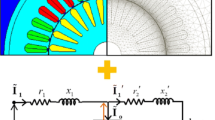Abstract
In this work, the low frequency electromagnetic flux density around induction motors is studied; the main objective is to provide safety regions for humans in the vicinity of these motors, especially in electrical vehicles, where high currents and hence high flux density emissions are expected. A new equivalent magnetic circuit which accounts for stray magnetic fields is developed. The analysis shows that the emission of the stray field in the radial directions depends on the permeability of the stator body as well as the ampere turn of the stator winding. Small values of stator body permeability may result in very high stray flux emissions at levels that may require shielding to protect passengers just above the motor. Relatively far away from the stator (e.g., 50 cm for the tested motors), the flux is normally of low level and may not represent an exposure threat.
Similar content being viewed by others
References
Wertheimer N, Leeper E (1979) Electric wiring configurations and childhood cancer. Am J Epidemiol 109: 273–384
IARC (2000) Non-ionizing radiation, Part I: static and extremely low frequency (ELF) electric and magnetic fields, vol 80. International Agency for Research on Cancer Monographs
Paniagua JM, Jimenez A, Rufo M, Gutierrez JA, Gomez FJ, Antolin A (2007) Exposure to extremely low frequency magnetic fields in an urban area. Radiat Environ Biophys 46: 69–76
WHO (1984) Extremely low frequency (ELF) fields. Environmental Health Criteria, vol 35. World Health Organization, Geneva
Wilson BW, Stevens RG, Anderson LE (1989) Neuroendocrine mediated effects of electromagnetics fields exposure: possible role of the pineal gland. Life Sci 45: 1319–1332
Petrucci N (1999) Exposure of the critically ill patient to extremely low-frequency electromagnetic fields in the intensive care environment. Int Care Med 25: 847–851
Reiter RJ (1995) The pineal gland and melatonin in relation to aging: a summary of the theories and of the data. Exp Gerontol 30: 199–212
Bearer CF (1994) Electromagnetic field and infant incubator. Arch Environ Health 49: 352–354
Aasen SE, Johnsson A, Bratlid D, Christensen T (1996) Fifty-hertz magnetic field exposure of premature infants in a neonatal intensive care unit. Biol Neonate 70: 249–264
Ashley JR, Myers B, Lilly HC, Beatie RE (1998) Measurement of potential magnetic field interference with implanted cardioverter defibrillators or pacemakers”, Electro 98. In: Professional Program Proceedings, pp 159–170, 9–11 June 1998
Le Coat G, Foggia A, Bongiraud JP, Le Thiec P (1999) Electromagnetic signature of induction machines. IEEE Trans Energy Conv 14(3): 628–632
IEEE 644 (1995) Standard procedures for measurement of power frequency electric and magnetic fields from AC power lines. 7 March 1995
IEEE Standard 291–1991 (1991) IEEE Standard Methods for Measuring Electromagnetic Field Strength of Sinusoidal Continuous Waves, 30 Hz to 30 GHz. 23 August 1991
Karady GG, Berisha ShH, Muralidhar M, Demcko JA, Samotoy M (1994) Variable Speed Motor Drive Generated Magnetic Fields. IEEE Trans Power Deliv 9(3): 1639–1646
Ferrari P, Mariscotti A, Motta A, Pozzobon P (2001) Electromagnetic Emissions from Electrical Rotating Machinery. IEEE Trans Energy Conv 16(1): 68–73
Ojo JO, Consoli A, Lipo TA (1990) An improved model of saturated induction machines. IEEE Trans Ind Appl 26(2): 212–221
Author information
Authors and Affiliations
Corresponding author
Rights and permissions
About this article
Cite this article
Koroglu, S., Adam, A.A., Umurkan, N. et al. Leakage magnetic flux density in the vicinity of induction motor during operation. Electr Eng 91, 15–21 (2009). https://doi.org/10.1007/s00202-009-0111-4
Received:
Accepted:
Published:
Issue Date:
DOI: https://doi.org/10.1007/s00202-009-0111-4




